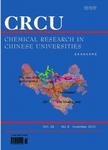Synthesis of CdS/m-Ti02 Mesoporous Spheres and Their Application in Photocatalytic Degradation of Rhodamine B Under Visible Light
Synthesis of CdS/m-Ti02 Mesoporous Spheres and Their Application in Photocatalytic Degradation of Rhodamine B Under Visible Light作者机构:Key Laboratory of Automobile Materials Ministry of Education College of Material Science and Engineering Jilin University Changehun 130012 P. R. China School of Physics Tonghua Normal University Tonghua 134002 P R. China State Key Laboratory of Inorganic Synthesis and Preparative Chemistry College of Chemistry Jilin University Changchun 130012 P. R. China
出 版 物:《Chemical Research in Chinese Universities》 (高等学校化学研究(英文版))
年 卷 期:2017年第33卷第3期
页 面:436-441页
核心收录:
学科分类:081702[工学-化学工艺] 081704[工学-应用化学] 07[理学] 08[工学] 0817[工学-化学工程与技术] 0703[理学-化学] 070301[理学-无机化学]
基 金:Supported the National Natural Science Foundation of China(Nos.21076094 and 21673097)
主 题:Cadmium sulfide Titanium dioxide Heteroarchitecture Mesoporous material Photocatalysis Visible light
摘 要:CdS/m-TiO2 heteroarchitecture with CdS nanocrystals loaded on mesoporous TiO2(m-TiO2) spheres was successfully synthesized via sol-gel method followed by solvothermal treatment. The material with uniform diameter of ca. 750 nm possesses regular mesoporous structure and large specific surface area of 100.5 m2/g. When used to photodegradate Rhodamine B(RB) under visible light, the CdS/m-TiO2 heteroarchitecture exhibits improved photo-catalytic performance in comparison with pure m-TiO2 or CdS. The excellent photocatalytic activity is closely related to the facilitated separation of electron-hole pairs derived from the CdS/m-TiO2 heterojunction and mesoporous structure with high specific surface area and adequately exposed active sites.



